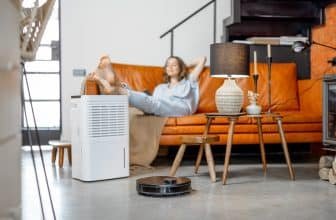Design and Aesthetics of Air Purifiers: Improving Air Quality and Enhancing Home Decor
The design and aesthetics of air purifiers have become a focal point in modern home decor, as people seek to maintain clean and healthy indoor environments without sacrificing style. These innovative devices are no longer just functional appliances but are also considered decorative elements that seamlessly blend into the overall design scheme of a home. As a result, manufacturers have responded with a variety of sleek and visually appealing air purifiers that cater to different interior styles, contributing to the overall aesthetics of the living space.

In recent years, the evolution of air purifier designs has seen a shift towards more minimalist and contemporary aesthetics, often resembling art pieces or stylish home accessories. This transformation has been driven by the increasing demand for air purifiers that not only deliver high-performance air filtration but also complement the interior design of modern homes. With these advancements, homeowners can now enjoy the dual benefits of improved air quality and enhanced visual appeal, making air purifiers an integral part of home decor.
Stylishly Pure: How Modern Air Purifiers Complement and Elevate Home Aesthetics
- Modern air purifiers are designed to seamlessly integrate into the aesthetics of a home, offering both functionality and visual appeal.
- The evolution of air purifier designs has resulted in sleek and minimalist aesthetics that cater to various interior styles, enhancing the overall decor of living spaces.
- The shift towards stylish and visually appealing air purifiers allows homeowners to prioritize clean air without compromising on the aesthetics of their home.
The Fundamentals of Air Purification

Air purifiers are devices that are designed to improve indoor air quality by removing pollutants and allergens from the air. They work by drawing in air from the room, filtering out airborne particles, and then releasing clean air back into the room.
Understanding Air Purifiers and Their Functions
Air purifiers come in different shapes, sizes, and designs. Some air purifiers use a single filter, while others use multiple filters to remove different types of pollutants. The most common types of filters used in air purifiers include HEPA filters, activated carbon filters, and UV-C light filters.
HEPA filters are designed to remove airborne particles such as dust, pollen, and pet dander. Activated carbon filters are designed to remove odors and chemicals from the air. UV-C light filters are designed to kill bacteria and viruses in the air.
Air purifiers also come with different features such as air quality sensors, automatic shut-off, and programmable timers. These features allow users to customize their air purifiers to their specific needs and preferences.
Air Quality and Health Impacts
Indoor air quality has a significant impact on health. Poor indoor air quality can cause a range of health problems such as allergies, asthma, and respiratory infections. Air purifiers can help improve indoor air quality by removing allergens and pollutants from the air.
Allergens such as dust, pollen, and pet dander can trigger allergies and asthma. Air purifiers with HEPA filters can remove these allergens from the air, reducing the risk of allergy and asthma attacks.
Airborne particles such as smoke, mold spores, and bacteria can also cause health problems. Air purifiers with activated carbon filters and UV-C light filters can remove these particles from the air, reducing the risk of respiratory infections and other health problems.
In summary, air purifiers are essential devices that can improve indoor air quality and promote better health. They come in different designs and with various features, making it easy for users to customize their air purifiers to their specific needs.
Design Evolution of Air Purifiers
Historical Design Trends
Air purifiers have come a long way since their inception in the early 1960s. The first air purifiers were bulky and industrial-looking, designed primarily for commercial use. Over time, air purifiers have evolved to become more compact, stylish, and efficient.
One of the earliest air purifiers was the Barach-Hall air purifier, patented in 1961. This bulky device used a combination of filters and ultraviolet light to purify the air. The first air purifier intended for domestic use was developed by Klaus and Manfred Hammes in 1963.
In the early 2000s, companies like Dyson, Blueair, and Coway began to revolutionize the air purifier market with sleek, modern designs that combined form and function. Dyson’s air purifiers, for example, feature a bladeless design that not only looks good but also reduces noise and improves air flow.
Modern Aesthetics in Air Purifiers
Today, air purifiers come in a wide range of styles and designs, from minimalist to retro-inspired. Manufacturers have realized that air purifiers not only need to be effective at purifying the air but also need to look good in the home.
For example, the Coway Airmega AP-1512HH air purifier has a sleek, modern design that fits seamlessly into any home decor. Its compact size and neutral color make it easy to blend in with any room.
Design is not just about good looks, but also about functionality. Air purifiers need to be easy to use, easy to maintain, and effective at purifying the air. This is why companies like Dyson and Blueair invest heavily in research and development to create air purifiers that not only look good but also perform well.
In conclusion, the design evolution of air purifiers has come a long way from bulky, industrial-looking devices to sleek, modern designs that combine form and function. Manufacturers have realized that air purifiers not only need to be effective at purifying the air but also need to look good in the home. Companies like Dyson, Blueair, and Coway continue to push the boundaries of air purifier design, creating devices that are both stylish and efficient.
Technological Advances in Air Purifiers

Air purifiers have come a long way from their humble beginnings as simple HEPA filter machines. Today’s air purifiers incorporate cutting-edge filtration technologies, smart features, and connectivity to provide a more comprehensive and effective air cleaning solution.
Cutting-Edge Filtration Technologies
HEPA filters remain the gold standard of air filtration, but they are not the only option available. Activated carbon filters, for example, are effective at removing odors and volatile organic compounds (VOCs) from the air. Some air purifiers even use a combination of HEPA and activated carbon filters to provide a more thorough air cleaning solution.
In addition to HEPA and activated carbon filters, some air purifiers use advanced filtration technologies such as ionizers and UV-C lights. Ionizers charge particles in the air, causing them to stick to surfaces and be removed from the air. UV-C lights kill bacteria and viruses in the air, providing an added layer of protection against airborne pathogens.
Smart Features and Connectivity
Modern air purifiers are not just effective at cleaning the air, they are also convenient to use. Many air purifiers come with smart features that allow them to be controlled using a smartphone app or voice commands through Google Assistant or Amazon Alexa.
Smart features such as automatic mode and air quality sensors allow air purifiers to adjust their cleaning intensity based on the level of pollutants in the air. This ensures that the air is always clean without wasting energy on unnecessary cleaning.
In conclusion, modern air purifiers are not just effective at cleaning the air, they are also aesthetically pleasing and convenient to use. With cutting-edge filtration technologies and smart features, air purifiers have become an indispensable tool for maintaining a healthy and comfortable home environment.
Performance and Efficiency

Air purifiers are designed to improve indoor air quality by removing pollutants and allergens from the air. The performance and efficiency of an air purifier are important factors to consider when selecting the most suitable device for your home.
Clean Air Delivery Rate (CADR) and Efficiency
Clean Air Delivery Rate (CADR) is a metric used to measure the effectiveness of air purifiers in removing pollutants from the air. A higher CADR rating indicates that the air purifier is more effective in removing pollutants from the air. CADR ratings are based on the volume of air that the purifier can filter per minute and the percentage of pollutants that are removed from the air.
When selecting an air purifier, it is important to consider the size of the room in which it will be used. A purifier with a higher CADR rating may be more effective in larger rooms, while a lower CADR rating may be sufficient for smaller rooms.
Efficiency is another important factor to consider when selecting an air purifier. High-efficiency particulate air (HEPA) filters are the most effective at removing particulate matter from the air. HEPA filters can remove up to 99.97% of particles that are 0.3 microns or larger in size.
Noise Levels and Quiet Operation
Noise levels are an important consideration when selecting an air purifier, especially if it will be used in a bedroom or other quiet space. Some air purifiers can be noisy, which can be distracting and disruptive to sleep or work.
Many modern air purifiers are designed to operate quietly, with noise levels below 50 decibels. Some air purifiers even have a “sleep mode” that reduces noise levels even further, making them ideal for use in bedrooms.
In addition to noise levels, energy efficiency is also an important consideration when selecting an air purifier. Energy-efficient models can help save on electricity costs over time, while also reducing your carbon footprint. Look for air purifiers with the ENERGY STAR label, which indicates that they meet energy efficiency guidelines set by the U.S. Environmental Protection Agency.
Overall, when selecting an air purifier for your home, it is important to consider factors such as CADR ratings, efficiency, noise levels, and energy efficiency. By selecting an air purifier that meets your needs in these areas, you can improve the air quality in your home while also contributing to a more aesthetically pleasing environment.
Air Purifiers in Different Living Spaces
Air purifiers can be used in various living spaces to improve air quality. Different living spaces have different requirements when it comes to air purifiers. In this section, we will discuss how air purifiers can be optimized for different living spaces.
Air Purifiers for Large Rooms and Open Spaces
Large rooms and open spaces require air purifiers with high CADR (Clean Air Delivery Rate) ratings. CADR is a measure of the volume of filtered air that an air purifier can deliver per minute. For large rooms, it is recommended to use air purifiers with a CADR rating of at least 300 for smoke, dust, and pollen.
Some air purifiers come with multiple filters and fans that can cover a larger area. For example, the Blueair Blue Pure 311i Max and Blueair Blue Pure 211i Max have a coverage area of up to 540 square feet and 540 square feet, respectively. These air purifiers are suitable for large living rooms, open spaces, and offices.
Optimizing Air Purifiers for the Bedroom and Nursery
Air purifiers can be especially useful in the bedroom and nursery, where people spend a significant amount of time. In these spaces, it is important to choose air purifiers that are quiet and have a night mode.
The Coway Airmega 250 has a sleep mode that reduces noise and turns off the display lights. The Levoit Core 300S also has a sleep mode that automatically adjusts the fan speed and reduces noise.
It is also recommended to choose air purifiers with HEPA filters that can capture small particles such as allergens, dust mites, and pet dander. The Honeywell HEPA InSight HPA5200B has a True HEPA filter that can capture up to 99.97% of particles as small as 0.3 microns.
Air Purifiers and the Kitchen Environment
Air purifiers can also be used in the kitchen to improve indoor air quality. Cooking can release pollutants such as smoke, grease, and odors that can affect air quality.
Air purifiers with activated carbon filters can capture these pollutants and reduce odors. The Clorox Medium Room air purifier has a pre-filter and an activated carbon filter that can capture cooking odors and smoke.
It is important to note that air purifiers should not be used as a substitute for proper ventilation in the kitchen. It is recommended to use air purifiers in conjunction with proper ventilation to improve indoor air quality.
In summary, air purifiers can be optimized for different living spaces based on their unique requirements. Large rooms and open spaces require air purifiers with high CADR ratings, while the bedroom and nursery require quiet air purifiers with HEPA filters. Air purifiers can also be used in the kitchen to reduce cooking odors and smoke.
Air Purifier Features and User Experience

Air purifiers come with a variety of features that can enhance the user experience. Some of the most notable features include adjustable fan speeds, modes, remote control, user-friendly features, and child lock.
Ease of Use and Maintenance
Modern air purifiers are designed to be user-friendly and easy to maintain. They often come with clear instructions and intuitive controls that make it easy to operate and customize the settings. Additionally, many air purifiers are equipped with filter replacement indicators that alert the user when it’s time to change the filter. This feature eliminates the guesswork and ensures that the air purifier is always operating at peak efficiency.
Adjustable Fan Speeds and Modes
Air purifiers come with different fan speeds and modes that allow the user to customize the air purification process. The fan speed determines how quickly the air is circulated through the air purifier, while the modes control the type of air purification that takes place. For example, some air purifiers have a sleep mode that operates quietly and at a low fan speed, making it perfect for use in a bedroom at night.
In conclusion, air purifiers are designed to improve air quality while enhancing the aesthetics of the home. By offering features such as adjustable fan speeds and modes, remote control, user-friendly features, and child lock, modern air purifiers provide an excellent user experience that is both convenient and effective.
Impact of Air Purifiers on Home Aesthetics

Air purifiers are no longer just functional devices that improve indoor air quality. They have evolved into stylish home accessories that can blend seamlessly with the existing home decor. The design and aesthetics of air purifiers have come a long way, and modern air purifiers are now available in a variety of shapes, sizes, and colors to suit different home interiors.
Blending Air Purifiers with Home Decor
One of the biggest advantages of modern air purifiers is that they can be integrated into a home’s existing decor without looking out of place. Many air purifiers are designed to look like decorative objects, such as vases, sculptures, or lamps, that can be placed on a shelf or table. For example, the Molekule air purifier features a sleek cylindrical design that resembles a modern art sculpture and can be placed in any room without looking out of place.
Air purifiers can also be customized to match the color scheme of the room. Some air purifiers come in a range of colors, while others feature interchangeable panels that can be swapped out to match the color of the walls or furniture. For example, the Dyson Pure Cool air purifier features a bladeless fan design that is available in a range of colors, including white, silver, and blue.
Air Purifiers as a Design Statement
In addition to blending in with home decor, air purifiers can also be used as a design statement. Many modern air purifiers feature sleek, minimalist designs that can add a touch of sophistication to any room. For example, the Coway AP-1512HH Mighty air purifier features a simple, yet elegant design that can complement any modern home decor.
Air purifiers can also be used to create a focal point in a room. Some air purifiers feature eye-catching designs or unique features that can draw attention and become a conversation starter. For example, the LEVOIT LV-H132 air purifier features a distinctive egg-shaped design that can add a touch of whimsy to any room.
In conclusion, air purifiers are no longer just functional devices that improve indoor air quality. They can be integrated into a home’s existing decor and used as a design statement. With a wide range of shapes, sizes, and colors available, air purifiers can complement any home interior and add a touch of sophistication to any room.
Health Benefits and Considerations

Air purifiers can provide numerous health benefits by improving indoor air quality in the home. Some of the health benefits include reducing exposure to allergens, asthma triggers, volatile organic compounds (VOCs), and other airborne pollutants.
Allergies, Asthma, and Air Purification
Air purifiers can be effective in reducing exposure to allergens such as pollen, pet dander, mold, and bacteria. For individuals with allergies or asthma, air purifiers can help alleviate symptoms and improve overall respiratory health. According to a study published in the Journal of Environmental Health Science & Engineering, air purifiers were found to be effective in reducing indoor PM2.5 concentrations, which can be harmful to individuals with respiratory conditions.
Reducing Exposure to Volatile Organic Compounds (VOCs)
Air purifiers can also help reduce exposure to VOCs, which are harmful chemicals that can be emitted from household products such as cleaning supplies, paints, and furniture. According to Cleveland Clinic, air purifiers can filter out fine particles and alter blood chemistry in a way that may benefit heart health.
When considering an air purifier, it is important to choose one that is appropriate for the size of the room and the type of pollutants you want to filter. HEPA filters are effective in removing small particles such as dust, pollen, and pet dander, while activated carbon filters are effective in removing VOCs and odors. It is also important to regularly replace filters to ensure the air purifier continues to effectively remove pollutants from the air.
Overall, air purifiers can be a valuable addition to the home by improving indoor air quality and providing numerous health benefits.
Choosing the Right Air Purifier

When it comes to choosing the right air purifier, there are several factors to consider. The following subsections will help you make an informed decision based on your needs.
Factors to Consider for Optimal Performance
The first factor to consider is the size of the room where the air purifier will be used. An air purifier that is too small for a room will not effectively clean the air, while one that is too large will waste energy and money. It is recommended to choose an air purifier that is rated for the square footage of the room.
Another important factor is the type of filter used in the air purifier. HEPA filters are the most effective at removing particles from the air, including dust, pollen, and pet dander. Some air purifiers also include activated carbon filters, which can remove odors and chemicals from the air.
It is also important to consider the noise level of the air purifier. Some models can be quite loud, which can be a distraction in a bedroom or other quiet space. Look for models that have a noise level of 50 dB or less for optimal comfort.
Budget-Friendly Options
For those on a budget, there are several options available that are both effective and inexpensive. Look for air purifiers that are Energy Star certified, as these models are designed to be energy-efficient and can save you money on your energy bill.
Another option is to choose a budget pick, such as the Clorox Medium Room air purifier. This model is effective at removing particles from the air and is priced affordably.
In conclusion, choosing the right air purifier is important for maintaining good air quality in the home. Consider factors such as room size, filter type, and noise level to ensure optimal performance. For those on a budget, Energy Star certified models and budget picks can provide effective and affordable options.
Frequently Asked Questions

What are the latest trends in air purifier designs for home interiors?
Air purifiers are no longer just functional devices, but also decorative ones that can complement a home’s decor. The latest trend in air purifier design is sleek, modern, and minimalist. Air purifiers with a clean, simple design that can blend seamlessly into any room’s decor are becoming increasingly popular. Some of the most popular designs include air purifiers with wooden accents, geometric shapes, and bold colors.
How do water-based air purifiers blend with home decor?
Water-based air purifiers are becoming increasingly popular in modern homes due to their ability to humidify and purify the air simultaneously. They come in a variety of designs that can complement a home’s decor. Water-based air purifiers are often designed to look like decorative vases or lamps, making them a functional and attractive addition to any room.
Can air purifiers be integrated into smart home systems without compromising design?
Yes, air purifiers can be integrated into smart home systems without compromising design. Many air purifiers now come equipped with Wi-Fi connectivity and can be controlled through a smartphone app. This means that users can control the air purifier’s settings remotely and even set up a schedule for when the air purifier should turn on and off.
What safety considerations are there when incorporating air purifiers into home aesthetics?
When incorporating air purifiers into home aesthetics, safety should be a top priority. It is important to make sure that the air purifier is certified by a reputable testing organization such as the Association of Home Appliance Manufacturers (AHAM) or the California Air Resources Board (CARB). Additionally, it is important to keep the air purifier away from flammable materials and to follow the manufacturer’s instructions for safe use.
How do natural air purification methods compare to modern air purifiers in design and efficiency?
Natural air purification methods such as plants and salt lamps are becoming increasingly popular in modern homes due to their ability to purify the air naturally. While these methods are often aesthetically pleasing, they may not be as efficient as modern air purifiers. Modern air purifiers use advanced technology to filter out harmful pollutants and allergens, making them more effective at improving indoor air quality.
What are the best practices for maintaining the aesthetic appeal of air purifiers over time?
To maintain the aesthetic appeal of air purifiers over time, it is important to clean them regularly. Most air purifiers come with a filter that needs to be replaced periodically. It is important to follow the manufacturer’s instructions for replacing the filter and to clean the air purifier’s exterior regularly. Additionally, it is important to place the air purifier in a location where it will not be knocked over or damaged.






